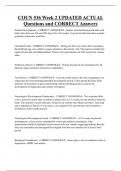COUN 536 Week 2 UPDATED ACTUAL
Questions and CORRECT Answers
Prenatal Development - CORRECT ANSWER✔✔- Begins with fertilization and ends with
birth, takes between 266 and 280 days (38 to 40 weeks). It can be divided into three periods:
germinal, embryonic, and fetal.
Germinal Period - CORRECT ANSWER✔✔- During the first two weeks after conception,
the fertilized egg, now called a zygote, attaches to the uterine wall. This period is marked by
rapid cell division and differentiation. There is the specialization of cells to perform various
tasks.
Embryonic Period - CORRECT ANSWER✔✔- During this period, the foundation for all
internal organs and body structures is established.
Fetal Period - CORRECT ANSWER✔✔- From the ninth week to the end of pregnancy, we
experience the most prolonged prenatal development period, in this period the fetus' body
structure will continue to grow and develop, and the finishing touches, such as the
development of fingernails and eyelids, will appear.
Neurological Development (Embryonic) - CORRECT ANSWER✔✔- The ectoderm folds
over to form the neural tube or primitive spinal cord. At 3½ weeks, the top swells to form the
brain. This primitive neural structure, housed in an embryo most likely less than 1 inch long
and weighing less than 0.15 of an ounce, can respond to its environment, most notably to
stimulation of the mouth and feet.
Neurological Development (Fetal) - CORRECT ANSWER✔✔- At 20 weeks of prenatal
development, a fetus can be stimulated by visual and auditory stimulation. Fetus
demonstrates ability to habituate and to arouse with new stimuli suggesting indicate that the
fetus can remember and distinguish the original from the new stimulus for at least a brief
period.
Biological Foundations - CORRECT ANSWER✔✔- Genes play a role in conditions such as
depression, ADHD, and autism.
, Polygenic - CORRECT ANSWER✔✔- Describes a characteristic that is influenced by many
genes.
Environmental Influences - CORRECT ANSWER✔✔- Teratogens/Maternal Stress
Teratogens - CORRECT ANSWER✔✔- Any agent or influence that can cause defects in the
developing embryo. There are numerous possible teratogens conveyed by pollution,
environmental toxins and prescription and non-prescription medications.
Maternal Stress - CORRECT ANSWER✔✔- Psychosocial, cultural and environmental
stressors experienced during gestation can be detrimental to pregnancy and maternal and fetal
health.
Maternal Stressors - CORRECT ANSWER✔✔- Physical stressors, such as malnutrition and
toxins like alcohol, nicotine, or polychlorinated biphenyls; psychosocial chronic stressors,
such as suffering from a psychiatric disorder, taking care of terminally ill relatives, or being
exposed to continuous violence (e.g., domestic violence or living in a war zone) or poverty
(e.g., famine or low socioeconomic status); and being exposed to severe incontrollable acute
trauma (e.g., natural disaster, terrorism, or genocide).
Maternal Stressors Impact on Offspring Neurodevelopment - CORRECT ANSWER✔✔-
Cognitive development, negative affectivity, difficult temperament and psychiatric disorders.
Birthing Process and Experience - CORRECT ANSWER✔✔- Labor induces fetal stress
hormones, such as cortisol, vasopressin and cortisol. It is believed that these hormones serve
as analgesics during birth, thus buffering or reducing the possibility of the fetus experiencing
pain in this process.
Apgar Scale - CORRECT ANSWER✔✔- A system of rating the physical condition of a
newborn baby; looks into health and viability. The assessment would evaluate heart rate,
breathing, muscle tone, color, activity - including grimace reflex response. A score of 7 or
better indicates that the infant is in good physical condition. If the score is between 4 and 6,
the baby needs assistance in establishing breathing and other vital signs. If the score is three
or below, the infant is in danger and requires emergency medical attention.




